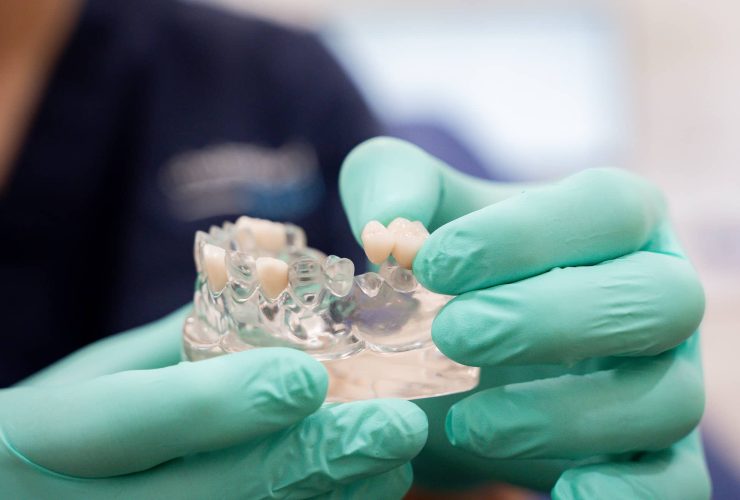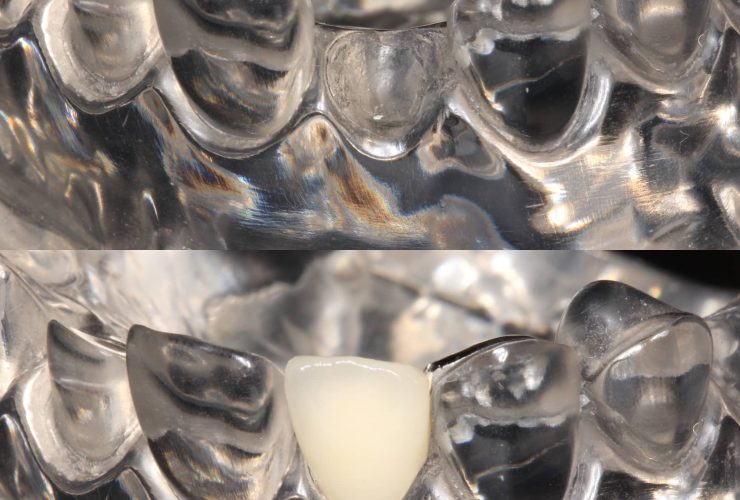A dental bridge is a fixed prosthetic device — usually made of porcelain or ceramic — that is designed to replace a missing tooth or teeth. The bridge is fused to a metal base, resulting in a secure, durable, natural-looking replacement for missing teeth.

The procedure for a dental bridge is less invasive than dental implants and can typically be completed in two appointments. Dental bridge treatment varies based on the type of dental bridge you choose and the condition of your teeth. Generally, the steps for a dental bridge involve:

If you have a missing tooth or teeth and healthy teeth on either side of the gap, you may be able to restore health and function to your mouth with a dental bridge. You may benefit from a dental bridge if:

Dental bridges offer benefits such as:
Traditional fixed bridges are used to fill the gap between two healthy teeth. The adjacent teeth are reshaped and fitted with crowns that serve to support the dental bridge between them. This common bridge type is made from either ceramic or porcelain material fused to metal.
If you have a single tooth missing in the middle or front of your teeth, a cantilever bridge is a common option. Cantilever bridges involve placing a crown on one side of the healthy adjacent tooth to support the bridge. It is rare to use a cantilever bridge on the back teeth as the force from chewing can damage the bridge.
A Maryland Bonded Bridge involves a floating tooth that serves to replace a missing tooth. Instead of completely covering the adjacent teeth, a Maryland Bonded Bridge is attached to existing teeth with metal framework. It involves less reshaping of adjacent teeth than traditional fixed dental bridges since no crowns are required.
While most dental bridges are permanently fixed, some individuals may be better suited to a removable dental bridge. Removable dental bridges are customised with a plastic base that matches the gums and gets secured with metal clasps to nearby teeth. Removable bridges are more affordable than dental implants or crowns but do not offer the level of durability or security provided by fixed dental bridges.
Our staff are more than happy to answer any questions or queries you may have.
After confirming you are a good candidate for a dental bridge during a consultation, your initial procedure will consist of preparing the teeth either side of the gap. This is done by removing a 1-2mm of the enamel of the tooth to make room for a crown to be placed over them.
A 3-D digital scan of the teeth is taken and sent to a local dental laboratory, where it is used to create a bridge that is custom-made for your mouth.
A temporary bridge is placed over the teeth while the permanent bridge is manufactured. At the next appointment, your dentist will replace your temporary bridge with the permanent dental bridge that gets cemented in place to the surrounding healthy teeth.
A dental bridge can also be anchored in place with a dental implant.
Consistent oral hygiene is crucial for maintaining your dental bridge. It is recommended to brush and floss at least twice a day and see your dentist for regular check-ups and cleanings.
When cared for properly, dental bridges can last for many years. Typically, the lifespan of a bridge is 5 to 15 years.
A crown is a cap used to restore function to a tooth, protect a badly broken down tooth from further damage, or improve a tooth’s appearance.
A bridge, unlike a crown, uses existing teeth to help fill in a gap left by a missing tooth. A bridge utilizes a prosthetic tooth that is anchored in the gap between the two adjacent teeth to establish a natural-looking appearance.
Both procedures are straightforward, safe, affordable and offered by our practice. Call Chelmsford Dental today to book a consultation with one of our dentists.
If you would like to learn more about dental bridges, please feel free to reach out to us. We would be happy to answer any questions or help you schedule a consultation.
Explore
© 2025 Chelmsford Dental Mount Lawley. All rights reserved. Privacy Policy. Web Design & SEO by Digital Hitmen.